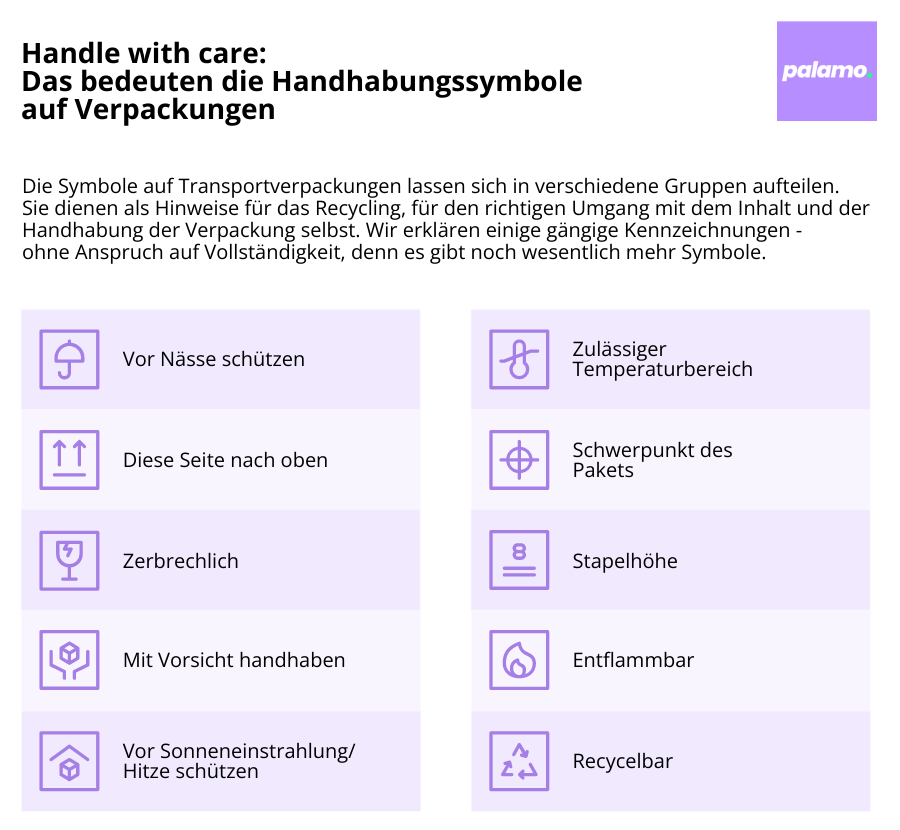Transport packaging differs from product packaging not only in the thickness of its walls. Their appearance is also designed for their actual purpose, the safe transport of goods to their sales area.
The kind of bold advertising messages that are typical of product outer packaging are therefore nowhere to be found on transport packaging. Instead, they are often provided with a multitude of pictograms and symbols, the meaning of which is not always immediately obvious.
Although designers of warning labels always try to make them self-explanatory, often enough questions remain unanswered. We have therefore compiled the most common symbols for transport packaging in this article.

You'll find plenty of information about packaging and beyond on the Palamo blog. |
What is the purpose of pictograms and symbols on transport packaging?
Pictograms and symbols on transport packaging are important information on how to handle the goods safely. They are intended to help prevent damage to the contents. In certain cases, they also serve to avert danger.
If the contents are dangerous goods, such as toxic, radioactive or virulent substances, special handling regulations apply to them. To ensure that all persons involved in the transport are informed about these dangers, the symbols and pictograms are attached.
But be careful: Warnings are the "last limit", which should ensure the safety of a transport good. Before that, all reasonable measures must be taken that can avoid or at least minimize the danger of or for a transport good.
You can by no means "safely glue" a transport shipment by using numerous stickers. Before that, the packaging, insulation and outer packaging of the goods to be transported must be designed to meet its particular requirements.
|
Handling instructions on the transport packaging serve in particular to ensure safety! |
What exactly are the pictograms and symbols on transport packaging called?
The pictograms and symbols on transport packaging are called "handling symbols". They primarily provide information on how to get the transported goods to their destination safely and without damage. Other handling symbols are indications on how to recycle the packaging materials.
How are handling symbols made and applied?
Shipping packaging can be subjected to heavy loads during transport. They are exposed to alternately warm and humid environments and are constantly moved. In addition, shipping packages are always stacked close together. This causes the packaging to rub against each other.
These are all conditions that are not ideal for handling symbols. They must therefore be placed in such a way that they remain legible at least for the time of transport.

Ideally, these instructions are therefore printed directly on the packaging. Stickers can always come off, which is why imprints are more advantageous here.
For cost reasons, however, these imprints are only implemented in one color or black. A good long-distance effect using high-contrast signal colors is therefore associated with greater expense. One possibility is to use colors and stencils.
Simple emulsion paints or spray paints are suitable for this purpose. Another option is to stick a large transparent film over the warning stickers.
What are the handling symbols?
Handling symbols are divided into the following groups:
- Instructions for the correct handling of the packaging
- Warning and handling information about the contents of the package
- Symbols on the subject of recycling.
The packaging serves to protect the contents during transport. However, the packaging itself can also be damaged by unfavorable influences and thus lose its protective effect for the goods being shipped. The following symbols are therefore often found on transport packaging:
-
Umbrella: "Protect from moisture".
This general note serves to protect the packaging against moisture penetration. Cardboard and paper packaging are particularly susceptible to moisture. The binder dissolves and the previously solid protection tears at the slightest movement. A typical measure is the use of shrink films or shrink hoods. Nevertheless, cardboard packaging should not be stored outdoors. -
Cube with roof and sun: "Protect from direct sunlight".
This symbol is used when the packaging is sensitive to UV radiation. In addition to cardboard, this also includes some types of plastic. PVC, for example, becomes brittle when exposed to UV radiation. The symbol is also used for live animals or dark packaging. In these cases, however, they indicate more the protection of the contents from overheating than the protection of the packaging itself. -
Square with arrow at top: "Permissible stacking load".
Transport packaging is often designed so that it can be stacked. However, this stacking load is limited. Adhering to the permissible stacking load ensures that the lower packages do not collapse. -
Circle with crosshairs: "Position of the centerof gravity".
Knowing the position of the center of gravity is very important when loading. Crane operators and forklift drivers thus know how to lift the container without it tipping or slipping. -
Forklift: "Attachment point for forklift truck".
A defined attachment point for forklift trucks ensures that the package is only lifted where the center of gravity is optimally positioned and where the packaging is sufficiently stable for the point load of the forklift truck fork. -
Trash can with little man: "Please recycle".
This friendly notice requests that the packaging be properly recycled after use. There may be further instructions on how exactly to do this.

The contents of a package can become a hazard in the event of uncontrolled leakage. Typical hazards are as follows:
- Fire hazard
- Explosion hazard
- radioactive rays
- bioactive material
- Health hazard due to gas, dust or aerosol
- Environmental hazard.
There are defined warning symbols for each hazard, which are usually self-explanatory. These can be explained in more detail by an additional text. These notes serve to be particularly careful when loading the packaging.
If the packaging is nevertheless damaged, the warning labels indicate that specialist personnel should be consulted for further action. Leaking ingredients marked in this way must never simply be cleaned up and the package resealed.
Less well known, but particularly important, are the number plates as found on packaging with hazardous contents. These consist of a conspicuous colored panel (red, yellow, green or white) and two numbers positioned one above the other and framed in black.

The upper number is the "hazard number" or "Kemmler number". It says something about the type of hazard. For example, "33" stands for a highly flammable liquid.
The lower number is the "UN number". It indicates what exactly the hazardous substance is. For example, the number "1203" stands for gasoline.
The purpose of these number plates is to be able to inform the security forces by telephone about the contents in the event of a leak. They then know what to expect and what countermeasures are required as soon as they arrive. Handling instructions for the packaging are intended to ensure that the contents reach their destination undamaged. Typical information of this type is as follows:
- Fragile
- Up here
- Weight specification
- Live animals
- Permissible temperature range.
By following the instructions, the probability that the goods will arrive safely increases. However, it is also true in this case that the packaging cannot be "written safe". The type and construction of the packaging must in any case be designed to protect the contents to a reasonable extent.
3. symbols on the subject of recyclingThe recycling of raw materials is becoming increasingly important. While cardboard packaging and metals are relatively easy to recycle, this is a major challenge, especially for plastics.
The problem with these materials is that there is no single "plastic" material. Rather, the polymers are highly diverse. Moreover, they cannot be mixed with each other without a severe loss of quality.

For plastics to be recycled, therefore, they must be sorted by type. For this purpose, plastics are provided with unique symbols that are intended to simplify manual sorting.
These symbols have recently been simplified once again. The plastics are now numbered according to their frequency. The uniform recycling symbol consists of a triangle formed by three curved arrows.
The number in the middle stands for a specific plastic. The exact type of plastic is indicated underneath. For the sorter, however, it is sufficient to sort the incoming plastics on the basis of the numbers.
These are the most common polymers in the packaging industry:
- 01: PET/PETE: PET (polyethylene terephthalate) is a stable plastic that is easy to recycle. It is the standard material for beverage bottles and other containers.
- 02: HDPE: HDPE is very related to PET. It means high-density polyethylene. HDPE has a higher density and is therefore more tear-resistant and stable. Since it also has high chemical stability, it is popular for shampoo or detergent.
- 03: PVC: PVC is called "polyvinyl chloride". The high chlorine content makes it difficult for recycling or thermal recovery. PVC products are often used for plastic products with long service life. Typical uses include water pipes, toys, or floor coverings. However, PVC is sensitive to UV radiation.
- 04: PE-LD: PE-LD is again a polyethylene, but this time with a particularly low density. It is less expensive than HD-PE. It is therefore often used for disposable packaging.
- 05: PP: PP stands for "polypropylene". It is a thermoplastic polymer. Its high strength makes it suitable for stable packaging such as transport boxes.
- 06: PS: PS is "polystyrene", better known under its brand name "Styrofoam". It is a foamed plastic used mainly as bumpers of fragile products. Polystyrene is readily recyclable. However, due to its low density and easy flammability, it often falls out of the recycling loop.
- 07: Other: Number 07 includes other types of plastic. They should nevertheless be recycled and not disposed of elsewhere. As a rule, they can still be processed into coarse plastic products such as park benches or sound barriers.

To learn more about labeling your package correctly, feel free to contact us! |
Conclusion: Correct labeling of packaging for safety and sustainability
Labeling packaging correctly is an effective contribution to transport safety and sustainable recycling. Equipped with clear instructions, all parties involved know exactly how to handle the packaging.
Working with the utmost care here protects against hazards, avoids transport damage, and ultimately benefits the environment. Transport packaging accounts for a large proportion of the waste generated each year.
Returning sorted waste to the recyclable material cycles not only ensures active environmental protection. It also saves valuable resources and ultimately company budgets. Even proper thermal recycling contributes to environmental protection by saving fossil fuels.
This shows how important proper labeling of transport packaging is today. However, care must always be taken to ensure that proper packaging comes first. Signage cannot compensate for deficiencies in shipping, but always acts only as a "last frontier".
Cover image: stock.adobe.com © Jörg Vollmer #4956041





